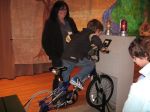“Look Up!” is the Earth Science component of the curriculum and is an introductory unit to astronomy. The sun-moon-earth system is the primary focus of this unit. Through hands-on activities, the students explore, examine and experiment with light and shadows, and movement. Using models and simulations the students explore how rotation causes day and night, investigate the phases of the moon in order to look for patterns in their data. Through outdoor observations made during the day and at night, active simulations, readings, videos, and discussions, students study the Sun, Moon, and stars to learn that these objects move in regular and predictable patterns that can be observed, recorded, and analyzed.
The third grade physical science unit “Lighten Up!”, builds on the energy concepts that are introduced in grade two and specifically focuses on electrical energy and magnetism. Students use scientific thinking processes to conduct investigations and build explanations: observing, communicating, comparing, and organizing.Using batteries, bulbs, wire, switches, and other materials the students identify the basic elements of simple electrical circuits, construct, compare and contrast series and parallel circuits, and learn about the conductive property of different materials. The electricity unit provides a natural context for students to develop their technology/engineering concepts and skills. Throughout the unit the students investigate the use of different technologies such as diodes and electromagnets and encounter various problem-solving situations, in which they can apply the engineering design process.
In the Life Science unit Classifying Living Things students examine; how organisms are classified, what are the characteristics of the different groups of organisms, what animal behaviors can be changed or learned, and how organisms respond to environmental factors. Through numerous inquiry-based investigations students discover that animals and other organisms are classified based on similar characteristics and that organisms can be classified into smaller groups. Students generate and formulate questions based on their observations, and design investigations to help answer their questions. Students also explore how organisms respond to different environmental factors such as moisture, light and temperature. Students generate, analyze and interpret data in order to explore new concepts such as environmental range and optimum range.



My class watched 2 bald eagles soar above Alcott School on Friday,
Nov. 16th at 10:40am.
What a surprise and a treat! A.Peduzzi